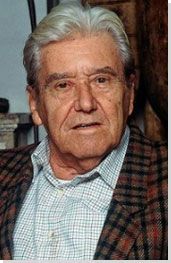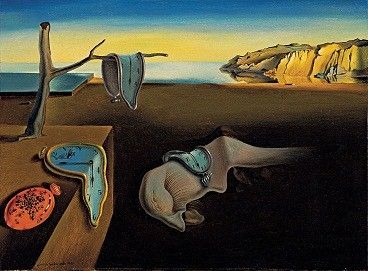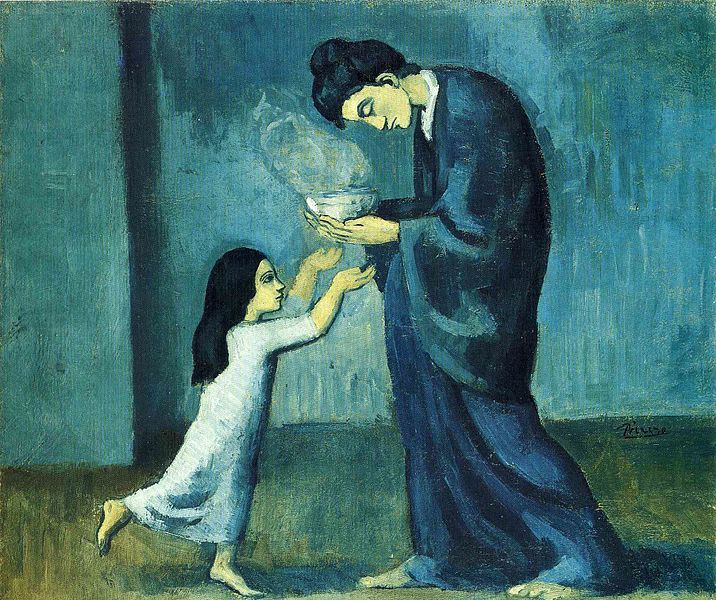Summary of Roberto Matta
Chilean-born artist Roberto Matta was an international figure whose worldview represented a synthesis of European, American, and Latin American cultures. As a member of the Surrealist movement and an early mentor to several Abstract Expressionists, Matta broke with both groups to pursue a highly personal artistic vision. His mature work blended abstraction, figuration, and multi-dimensional spaces into complex, cosmic landscapes. Matta's long and prolific career was defined by a strong social conscience and an intense exploration of his internal and external worlds.
Accomplishments
- Matta broke with the conventions of the Surrealist movement by adding a dimension of social and political awareness to his work.
- Matta often supplemented an aesthetic of pure abstraction with elements of figuration and precisely rendered, though fantastically conceived, three-dimensional space.
- Matta's exploration of the unconscious mind through a symbolic language of abstract forms greatly influenced the early development Abstract Expressionism.
Important Art by Roberto Matta
Cruxificion
Cruxificion marks not only Matta's first foray into oil painting, but also the start of what he called his Psychological Morphologies. While it has been suggested that the main forms in this painting represent Jesus and Mary, what is most striking about this work is its abstraction. The painting was created using the Surrealist practice of automatism. Matta utilized this technique as a means to depict a constantly transforming, multi-dimensional time and space. He believed that this allowed for a vision of reality that existed beyond the limits of normal human perception.
Oil on canvas - Private Collection
The Earth is a Man
Matta produced The Earth is a Man after being greatly affected by the dramatic landscape during a trip through Mexico in 1941. The painting depicts the earth as a volatile and constantly evolving space. The composition is dominated by what appears to be either an exploding sun or erupting volcano in the left center of the piece. For Matta, this symbolized a personal outpouring of emotions and ideas. Volcanoes also appeared in several other works from this period, such as Invasion of the Night (1941) and Ecouter vivre (1941). Interestingly, The Earth is a Man shares its name with an epic poem Matta composed in 1936 to commemorate Frederico Garcia Lorca's violent death.
Oil on canvas - Private Collection, Chicago
Being With (Etre Avec)
As one of Matta's "Social Morphology" paintings, Being With (Etre Avec) represents a direct response to the horrors of the Second World War. Matta's deep-seated dismay finds expression in the menacing mechanical contraptions and the contorted, violently violated humanoid forms that populate the painting. The figures here are reminiscent of both totemic art and Alberto Giacometti's sculptures. Furthermore, the influence of the contemporary Mexican muralists can be seen in this work's increased scale, at 87 x 180 inches, and Matta's explicit engagement with social issues.
Oil on canvas - The Metropolitan Museum of Art, New York
Etre Cible Nous Monde
Exemplery of Matta's work from the mid1950s, Etre Cible Nous Monde shows a cosmic landscape dominated by a fantastical machine highly reminiscent of Duchamp's The Large Glass .. (1915-1923). The imagery and title of the painting (loosely translated as, "Our Earth is a Target") hint at the paranoia and fear associated the atomic age, exacerbated by the Cold War and the Space Race. These fears were intensified by Russia's launch of the Sputnik satellite in 1957.
Oil on canvas - Private Collection, Geneva
The First Goal of the Chilean People
Matta was dedicated to the notion of fostering an artistic and social renaissance in Latin America, particularly in his native Chile. He painted the massive, cartoon-like wall mural, The First Goal of the Chilean People, in honor of the 1970 political victory of Socialist president Salvador Allende. When military dictator Augusto Pinochet took power in 1973, he had the work covered in sixteen coats of paint. It was thought that the mural was lost forever until local officials uncovered it in 2005 and took three years to restore it.
Wall mural - La Granja City Hall, La Granja, Chile
La Source du Calme (The Source of Calm)
La Source du Calme (The Source of Calm) was Matta's final composition before his death. Like much of his later work, this print exhibits brighter colors, softer forms, simplified figures and an overtly spiritual mindset. This turn to more mystical and mythological themes echoes similar sentiments expressed by authors of the Latin American literary renaissance, like Gabriel Garcia Marquez. Significantly, it also represents a return to the themes of past Latin American authors, such as Garcia Lorca, with whom Matta was closely involved.
Carborundum etching on hand-made paper - RoGallery, Long Island City, NY
Biography of Roberto Matta
Childhood
Known primarily as 'Matta,' Roberto Antonio Sebastian Matta Echaurren was born in Santiago, Chile on November 11th, 1912. The son of a Chilean father and a Spanish mother, Matta grew up in a strictly Catholic, upper middle-class home. His mother was well read and highly cultured, fostering Matta's interest in art, literature, and languages. He received a classical, Jesuit education, and enjoyed a comfortable childhood during a period of widespread economic hardship in Chile.
Early Training
From 1929 through 1933, Matta studied architecture and interior design at the Sacre Coeur Jesuit College and the Universidad Catolica of Santiago. In his final year of school, Matta devised an ambitious architectural project called the "League of Religions." Signaling an early interest in both biomorphism and fantastical spaces, his building designs were modeled after suggestively posed female bodies. Not long after this project, Matta left behind his privileged upbringing and conservative education to join the Merchant Marines. He settled in Paris, France, in 1935, becoming an apprentice in modernist architect Le Corbusier's studio. He stayed on to work with Le Corbusier for the next two years.
During this time, Matta established close friendships with several members of the Latin American literary avant-garde. His relationships with Frederico Garcia Lorca, Pablo Neruda, and Gabriela Mistral proved particularly influential. It was through Lorca that Matta was introduced to Surrealist artist Salvador Dalí. Dalí, in turn, encouraged the young artist to show some of his drawings to André Breton. Sensing an emerging talent and common spirit, Breton bought several of Matta's drawings and invited him to officially join the Surrealist group in 1937.
The same year, Matta worked with the architects designing the Spanish Republican pavilion at the Paris International Exhibition. Here, Matta saw Pablo Picasso's seminal work, Guernica (1937). The work's mixture of formal abstraction and social consciousness had a lasting impact on the development of Matta's own personal style and artistic practice. Equally as influential was Marcel Duchamp's Large Glass (The Bride Stripped Bare by Her bachelors, Even) (1915-23), which Matta also encountered around this time. He later referenced this work explicitly in The Bachelors Twenty Years After (1943), and he continued to reference Large Glass throughout his career. Duchamp's influence can be seen particularly in the complex multi-dimensional spaces and fantastical machines that define much of Matta's mid-career work.
Mature Period
Matta's earliest works were abstract crayon drawings produced using the Surrealist practice of automatism. In these drawings, he referenced organic growth patterns, microscopic views of plants, and the non-Euclidean geometry described by mathematician Jules Henri Poincare. Matta transitioned from drawing to oil painting in 1938, while working in Brittany with the British artist Gordon Onslow Ford. The works that Matta created around this time were the first of what he called his "Psychological Morphologies." In these paintings, Matta explored his subconscious mind through a language of abstract forms and constantly evolving, multi-dimensional spaces. Matta also referred to these works as "Inscapes," with the implication that they depicted the interior landscape of the artist's mind, interconnected with his external reality.
Matta was well established within the Surrealist group by the time that he was forced to flee Europe for America in the fall of 1939. When Matta arrived in New York City, he was the youngest and most outgoing of Surrealist emigres. These traits, combined with a shared interest in automatist art-making techniques, allowed Matta to quickly form relationships with several of the young New York School artists. Throughout the first half of the 1940s, Jackson Pollock, Arshile Gorky, William Baziotes, Peter Busa, Robert Motherwell, and others met frequently with Matta to learn about his personal ideas about Surrealism.
In the mid-1940s, Matta's work changed dramatically. Responding to the continuing horrors of the Second World War, Matta expanded his artistic interests beyond his exploration of the subconscious mind. He moved towards a more active engagement with the world in a series of works that he called "Social Morphologies." Many of Matta's paintings from this period incorporate strangely menacing, machine-like contraptions and totemic human forms. He pitted these elements against each other in seemingly constant battle within a landscape of amorphous spaces and vaguely architectural planes. These works have a new emotional immediacy, reverberating with a formal tension created by the often violently oppositional forms.
Matta enjoyed increased professional and creative success in the mid-1940s. Yet, his new use of figuration and narrative created a significant intellectual rift with both the Surrealists and Abstract Expressionists. Matta's life was further thrown into chaos in 1948, when his close friend, Arshile Gorky, committed suicide. Many in the New York Surrealist circle blamed Matta, who had been having an affair with Gorky's estranged wife. Breton publicly expelled Matta from the Surrealist group. This action has been attributed not only to Matta's social infraction, but also to his increased interest in exploring social and political issues through his work.
Ostracized by the artistic community in New York, Matta returned to Europe in 1948. He moved first to Italy, and then, beginning in 1955, kept residences in both Paris and Rome. The Surrealists eventually invited Matta to rejoin their group in 1959. He declined their offer, preferring instead to continue his artistic explorations on his own.
Late Period
Matta traveled widely throughout Europe, Latin America, and Africa during the 1950s and 1960s. During this time, he became even more politically and socially engaged. Matta wholeheartedly believed that art could be a powerful agent for societal change. Much of his work during the next two decades was created in explicit response to contemporary events like the Civil Rights movement and the wars in Vietnam and Algeria. His paintings also became more narrative in the 1950s. They frequently featured totemic figures set within multi-planar environments filled with strange, science-fiction-like machines.
Beginning in the 1960s, Matta dedicated himself to political and social issues in Latin America. During this time, Matta also traveled multiple times to Chile. He strongly supported Salvador Allende's Socialist government, and the newly elected president even invited Matta to be Chile's cultural attache. The artist found great professional and spiritual fulfillment in his home nation until the rise of Pinochet's military dictatorship in 1973. Perhaps the zenith of Matta's engagement with Latin American cultural themes was his group of works produced in 1983 titled, El Mediterano y el Verbo Americas. In this series of poems and paintings, Matta created an analogy between the Latin American and European cultural renaissances. He presented the idea of "America" as verb - constantly moving, evolving, and changing.
Matta was the subject of several significant exhibitions in the later half of his career. Most notably, he received retrospective shows at the Museum of Modern Art in New York in 1957, the National Gallery in Berlin in 1970, and the Pompidou Center in Paris in 1985. During these years, Matta broadened the scope of his artistic practice. He began adding clay to some of his paintings in the early 1960s, and over the next thirty years experimented extensively with printmaking, tapestry, ceramics, furniture making, and sculpture. Many of Matta's works from his final decades exhibit a lightening of tone and color, and a turn towards more timeless, mythological, and mystical subject matter.
In his last years, Matta split his time between France, England, and Italy, where he operated a studio, gallery, and pottery school. He continued to travel, work, and engage with contemporary political concerns until his death in Civitavecchia, Italy, in 2002.
The Legacy of Roberto Matta
Throughout a long and fruitful career that spanned six decades and multiple continents, Matta established himself as one of the central figures in the Surrealist movement. Yet, while he certainly shared stylistic and intellectual similarities with the Surrealist group, he was never able to completely reconcile his strong social conscience with its necessarily inward-looking practices. Instead, Matta balanced his interest in the human psyche with an active engagement with the external world. In the process, he provided early and crucial inspiration for the Abstract Expressionists. Matta's artistic legacy was also a deeply personal one, as four of his six children became notable artists as well. Most celebrated among his progeny was the contemporary artist Gordon Matta-Clark, who followed in his fathers footsteps by creating socially conscious work with a distinctively architectural bent.
Influences and Connections

-
![André Breton]() André Breton
André Breton ![Frederico Garcia Lorca]() Frederico Garcia Lorca
Frederico Garcia Lorca![Gabriela Mistral]() Gabriela Mistral
Gabriela Mistral![Jules Henri Poincare]() Jules Henri Poincare
Jules Henri Poincare![P.D. Ouspensky]() P.D. Ouspensky
P.D. Ouspensky
Useful Resources on Roberto Matta
- Transmission: The Art of Matta And Gordon Matta-ClarkBy Briony Fer, Betti-Sue Hertz, Pastor Mellado, and Anthony Vidler
- Matta: Surrealism and beyondOur PickBy Curtis L. Carter
- Matta: A Centennial CelebrationBy Roberto Matta and Justin Spring
 Ask The Art Story AI
Ask The Art Story AI






























